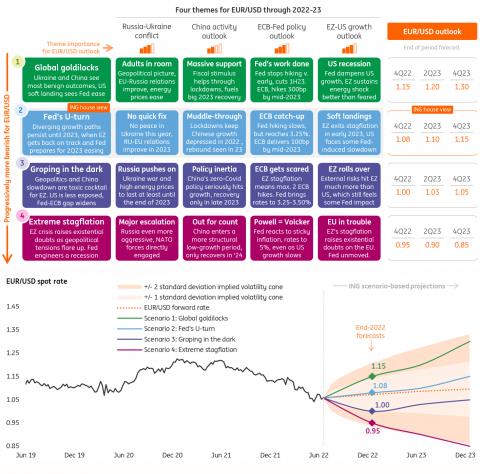(MENAFN- ING) Four potential paths for EUR/USD into 2023
Making the correct call on EUR/USD over the next 18 months will depend on four key drivers:
- The Russian-Ukraine war and what it means for European growth and the commodity supply shock
- Chinese growth and what it means for global demand and the global supply chain shock
- The Fed-ECB policy trade-off and to what degree it pushes differentials wider still
- US-eurozone growth prospects and what it means for global equity and FDI flows
Below we outline four scenario paths for EUR/USD into the end of 2023. We have generated the possible range of EUR/USD end-2023 outcomes using expected volatility embedded into current FX options market pricing. The extreme ranges for end-2023 EUR/USD levels, 1.30 under Scenario 1 and 0.85 under Scenario 4 derive from the two standard deviation outcomes.
Of the four scenarios presented, Scenario 2, 'Fed's U-turn' is our baseline scenario. Given that Fed policy has been such a large driver of dollar pricing since June 2021, when Fed dot plots suggested the central bank would be normalising policy after all, a Fed shift from hiking in 2022 to cutting in 2023 should take some upside pressure off the dollar. We look for a weak EUR/USD rally through 2023 as the Fed eases and some of the headwinds to growth, including China, abate.
Briefly discussing extremes, the most bullish EUR/USD story (1.30) is one of global growth recovering (somehow) in 2023 at a time when the Fed feels it can cut rates back to more neutral levels near 2.00%. The most bearish EUR/USD scenario is an early 1980s-style stagflation, where the Fed needs to continue hiking aggressively even as the global economy enters a recession. This reopens friction within the eurozone.
4 themes for EUR/USD

ING
Financial fair value: Where rate spreads and equities can drag EUR/USD
Above, we have outlined some stylised scenarios of where major drivers could place EUR/USD over the next 18 months. Quantitatively, we do not think EUR/USD is particularly cheap on a medium-term fundamental basis . But other shorter-term techniques also have a quantitative say in EUR/USD pricing. Here, we use a financial fair value model to identify short-term fair value for EUR/USD.
Typically, factors like two-year EUR-USD swap spreads or the equity environment have two of the highest betas in the model. As shown in the left-end chart below, these two factors explain nearly all the drop in EUR/USD fair value since the start of 2022, while the other two inputs in the model - the relative shape of the yield curve and relative equity performance – have had a negligible impact, displaying considerably lower betas in the model.
In the right-end chart below, we present a matrix of swap spreads versus equity outcomes - which, as discussed, are the main drivers of EUR/USD - to provide some flavour as to where EUR/USD could be trading under very different market conditions.
ING, Refinitiv
It must be noted that this matrix looks at short-term dynamics, and its explanatory power over the medium term – i.e. beyond 12 months - would decrease substantially as other (longer-term) factors would start to play a bigger role.
The purpose of this matrix is to provide an indication of what combination of ECB-Fed monetary policy differential and global risk environment would be required to trigger some sizeable moves in EUR/USD over the next 12 months.
In the scenario analysis outlined at the start of this article, we considered the“global Goldilocks” scenario as the most optimistic for EUR/USD, with the pair reaching 1.20 in the next 12 months. As shown in the matrix, that would require both a rebound in global equities beyond the January 2022 peak (+30%) and a complete erosion of the ECB-Fed policy differential.
In the other extreme scenario (“extreme stagflation”), we implied a move to 0.90 by 2Q23. This would require a significant repricing higher in the Fed's policy path relative to the ECB's, as well as a further drop in global equities to the levels last seen in the spring of 2020.
In our base-case scenario (“Fed's U-turn”), a return to 1.08 is achievable via a gradual recovery in risk sentiment and a stabilisation in the short-term rate differentials around current levels. Below are the details of our current quarterly forecasts.
Our forecasts and the consensus view
ING, Consensus Economics
MENAFN23062022000222011065ID1104424314
Author:
Chris Turner, Francesco Pesole
*Content Disclaimer:
This publication has been prepared by ING solely for information purposes irrespective of a particular user's means, financial situation or investment objectives. The information does not constitute investment recommendation, and nor is it investment, legal or tax advice or an offer or solicitation to purchase or sell any financial instrument. Read more here: https://think.ing.com/about/disclaimer/
Legal Disclaimer:
MENAFN provides the information “as is” without warranty of any kind. We do not accept any responsibility or liability for the accuracy, content, images, videos, licenses, completeness, legality, or reliability of the information contained in this article. If you have any complaints or copyright issues related to this article, kindly contact the provider above.